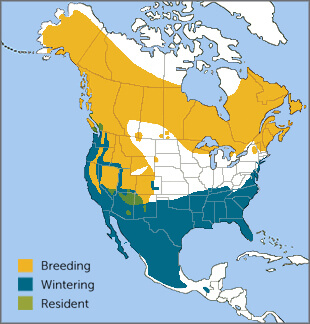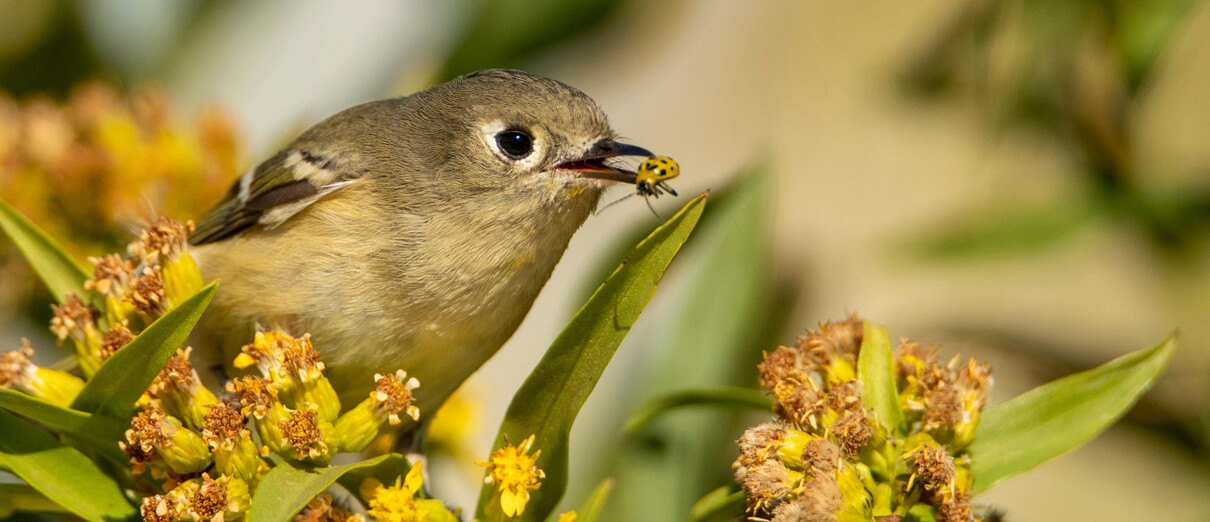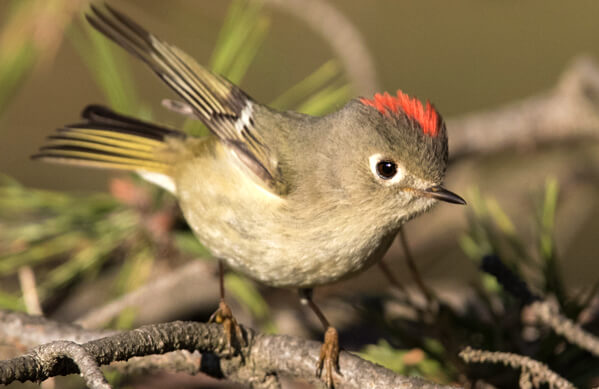
Ruby-crowned Kinglet range map by American Bird Conservancy
One of North America's smallest songbirds, the Ruby-crowned Kinglet is tinier than a Black-capped Chickadee and only a bit larger than a Ruby-throated Hummingbird. Unremarkable at first glance, this diminutive bird is a drab olive-green and gray, with a white eye ring and wing bars. But a closer look reveals that this flitty songbird is anything but boring.
Its genus, Regulus, means "little king" in Latin. True to its name, when the male kinglet is excited or agitated, he raises his scarlet "crown." Females lack the red crest but otherwise look identical to males.
Wing-flicking Ways
The Ruby-crowned Kinglet rarely sits still, flitting, hopping, and flying around in short, energetic dashes. As it moves, it constantly flicks its wings — and it's this ceaseless motion that makes identification easy. A few other species, such as the related Golden-crowned Kinglet and the Hutton's Vireo of the western U.S., flick their wings, but none as constantly as the Ruby-crowned Kinglet.
Wide-ranging Kinglet
Three subspecies of Ruby-crowned Kinglet are recognized, distributed across northern, western, and some eastern parts of North America. This species can be found in a wide variety of habitats, including coniferous and deciduous forests, thickets, scrub, and edge. During migration, the Ruby-crowned Kinglet is often sighted in suburban yards as well. In its winter range, this bird favors low woodland habitats.
Most Ruby-crowned Kinglets migrate to the southern U.S. and Mexico each winter, although some western populations are permanent residents. The Ruby-crowned Kinglet lingers later into fall than do other insect-eating birds such as the Blue-winged Warbler and the Wilson's Warbler. The kinglet can linger because in addition to insects, it will also eat berries and suet at feeders.
The Ruby-crowned Kinglet's loud, jumbled song belies its tiny size. This three-part ramble consists of a series of high-pitched notes, two to five low trills, and a repeated three-note "galloping" phrase that can vary by individual. One of its most distinctive calls is a dry "ji-dit," often heard before the tiny bird is spotted.
Listen here:
(Audio: Ruby-crowned Kinglet song by Andrew Spencer, XC104679. Accessible at www.xeno-canto.org/104679. Ruby-crowned Kinglet call by Ryan P. O'Donnell, XC75105. Accessible at www.xeno-canto.org/75105.)
Fidgety Feeder
The Ruby-crowned Kinglet is mainly insectivorous, feeding on beetles, flies, moths, ants, and wasps, along with spiders. It also will eat some fruit and berries, including elderberry, poison ivy, and wax myrtle; drink tree sap; and visit suet feeders.
This little dynamo forages ceaselessly from treetops to low brush, closely examining foliage, twigs, and tree limbs for food. It often hovers while gleaning and sometimes darts out to catch insects in mid-air.
From fall into spring, the Ruby-crowned Kinglet often joins small feeding flocks with other woodland birds, including the Downy Woodpecker, Yellow-rumped Warbler, and White-breasted Nuthatch.

Ruby-crowned Kinglet gleaning an insect. Photo by Jackie Connelly-Fornuff/Shutterstock
Champion-sized Clutches
The Ruby-crowned Kinglet is monogamous during the nesting season but usually pairs up with a new mate each year. A male courts his chosen female by hopping around her while singing and displaying his bright crest.
Once mated, the female chooses a nesting site, usually high in a conifer, close to the trunk and concealed by overhanging branches. She builds her cup-shaped nest with an outer layer of mosses, lichens, spider web, bark, and conifer needles, lining it with finer, softer materials, including animal fur.
Female Ruby-crowns lay the largest clutch relative to size of any North American songbird, packing the nest with nine to 10 eggs, but sometimes as many as 12! This species raises a single brood each year — understandable given this large clutch size. This unusual productivity offsets a high rate of winter mortality, particularly during severe and prolonged cold weather.
The male kinglet brings food to his mate while she broods, then helps to feed the nestlings after they hatch. Both sexes fiercely defend their nesting territory, mobbing potential predators such as jays, squirrels, hawks, and even people.
Stable Yet Vulnerable
Partners in Flight data show a stable population trend for the Ruby-crowned Kinglet, which remains widespread and common. Like the Carolina Wren, its numbers may fluctuate due to winter die-offs, especially in cold years, but the Ruby-crowned Kinglet's ability to use a variety of habitats outside of the breeding season has allowed it to adapt and thrive.
Large numbers of this kinglet, however, are killed by collisions, particularly with towers, during their nocturnal migrations. Many fall victim to outdoor cats as well. ABC has programs in place to tackle these threats, including our Collisions program, which offers solutions to birds hitting towers and windows; and our Cats Indoors program, which encourages pet owners to keep cats and birds safe.
Donate to support ABC's conservation mission!



















































